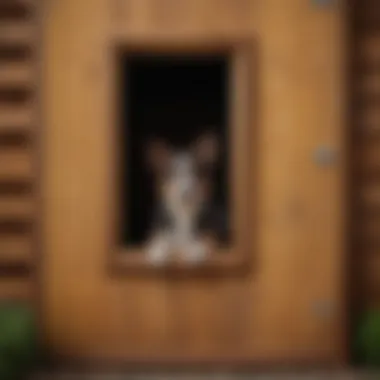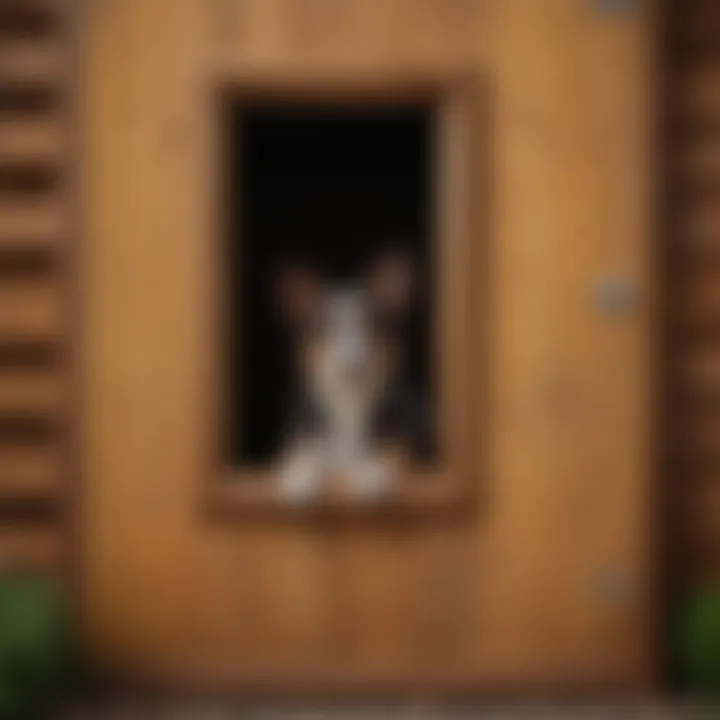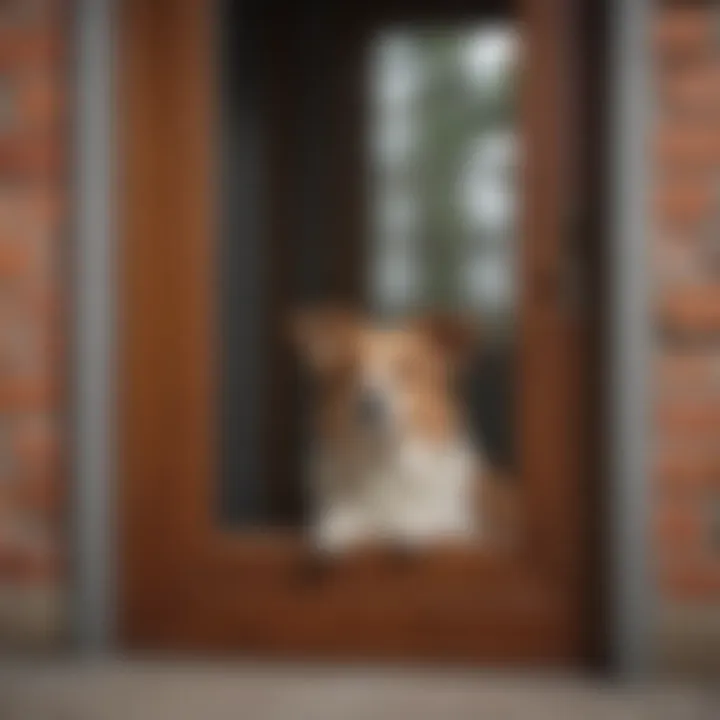Understanding Dog Doors for Dog Houses: A Comprehensive Guide


Intro
When considering the needs of your dog, one aspect often overlooked is the choice of a suitable door for their dog house. A dog door tailored for a dog house allows greater freedom for your canine companion, facilitating easy access to outdoor spaces without constant human intervention. This is not just about convenience; it is also an element of their safety and well-being. As we delve deeper, we will explore the key aspects surrounding dog doors designed for dog houses. From types and installation to benefits and challenges, this guide aims to provide comprehensive knowledge on the subject.
Topic Overview
Definition and Importance
Dog doors for dog houses are specially designed openings that allow dogs to enter or exit freely. They serve multiple purposes, including providing your dog with their own space to go outside at will, reducing the stress for both you and your pet. This kind of independence enhances their quality of life and promotes physical exercise through outdoor exploration.
Brief History and Evolution
Dog doors have been around for quite some time. Initially, they were simple openings cut into the walls or doors of houses. Over time, the designs have evolved to include various materials and mechanisms. Nowadays, automatic, microchip-activated, and insulated options are available, catering to different needs and preferences of pet owners. This evolution highlights the increasing understanding of the importance of pet comfort and safety.
Types of Dog Doors
Dog doors come in various styles. Each type has distinct features aimed at optimizing your dog's experience.
- Flap Dog Doors: The classic design. It consists of a flexible flap that your dog pushes open to enter or exit.
- Electronic Dog Doors: These work with a sensor, allowing only your dog to use the door when they approach.
- Insulated Dog Doors: Designed to minimize heat loss or gain, these doors are ideal for extreme climates.
Installation Process
The installation of a dog door can seem daunting, but with the right approach, it becomes manageable. Here’s a step-by-step process for your reference:
- Choose the Location: Identify the best place for the dog door based on your dog's size and accessibility needs.
- Measure Your Dog: Ensure the door size is appropriate for your dog's breed and size.
- Purchase the Door: Select a door that fits your needs from hardware stores or online.
- Prepare the Wall or Dog House: Cut the appropriate opening if necessary, taking care to maintain structural integrity.
- Install the Dog Door: Follow the manufacturer's instructions closely. Secure it properly to prevent any issues later.
Benefits of Dog Doors
The advantages of installing a dog door are numerous. They can include:
- Increased Independence: Dogs can come and go as they please.
- Reduced Anxiety: Less stress for both owners and pets, as there is no need for owners to constantly open the door.
- Enhanced Comfort: Access to fresh air and sunshine can improve your dog’s living environment.
Maintenance and Security Considerations
Owning a dog door comes with some responsibilities. Regular maintenance is essential to ensure the door remains functional. Clean any dirt or debris that may accumulate. Check the sealing to prevent drafts.
Security is another concern. Ensure the door mechanism (especially electronic ones) is reliable, and consider locking options when necessary to prevent unauthorized access.
"A well-installed dog door can significantly enhance your dog's quality of life, providing him or her with the freedom to enjoy both indoor and outdoor settings."
Finale
Understanding dog doors for dog houses opens up a realm of possibilities for enhancing your dog's life. By choosing the right type of door, following proper installation techniques, and addressing maintenance needs, you create an environment that promotes your pet’s well-being and happiness. The right approach to incorporating a dog door results in a more harmonious living experience for both you and your furry friend.
Intro to Dog Doors
Dog doors serve a critical function, especially for those who own dog houses. These essential additions provide dogs with freedom and ease of access to the outdoors. In this section, we will delve into the importance of dog doors and why they are not merely a convenience, but a necessity in certain scenarios. By understanding their role, pet owners can make informed decisions regarding the best options for their canine companions.
The Necessity of Dog Doors
The need for dog doors transcends the basic convenience they provide. For dogs, having a direct route to their outside environment can enhance their overall well-being. This access promotes independence, allowing pets the ability to relieve themselves or explore without the constant need for human intervention. Additionally, dog doors help to develop healthy habits by encouraging physical activity.
Moreover, in regions with inclement weather, dog doors can prove beneficial. They allow pets to enter and exit without requiring owners to constantly open doors, thus reducing indoor messes. Hence, dog doors reduce stress on both pets and owners alike, contributing to an easier companionship.
Overview of Dog House Features
A well-designed dog house not only provides shelter but can also harmonize with the installation of dog doors. When considering dog doors, one must also think about existing features. For instance, ventilation is crucial. Proper airflow within the dog house is necessary to maintain a healthy living space for the dog.


Moreover, insulation is a consideration. A dog house with good insulation paired with a dog door can help to maintain a comfortable temperature inside, regardless of external weather conditions. Hence, understanding underlying dog house features is vital when selecting a dog door.
In summary, dog doors are an integral part of ensuring a functional and supportive living environment for dogs. Their necessity is evident, particularly when considering the broader context of dog house features and the overall well-being of the pet.
Types of Dog Doors
Understanding the various types of dog doors is crucial when selecting the best option for your dog house. Each type comes with distinct features, benefits, and considerations that cater to different needs. Evaluating these options ensures that dog owners can choose the one that enhances their dog's comfort, safety, and independence.
Flap Dog Doors
Flap dog doors are one of the most common choices for dog houses. These doors typically consist of a flexible flap made from durable material, allowing dogs to enter and exit freely. The ease of use is a significant advantage, as dogs quickly learn to push through the flap. It's essential to select a well-insulated flap to minimize heat loss or cold drafts, depending on the climate. Flap doors provide a straightforward solution for many pet owners.
Electronic Dog Doors
Electronic dog doors represent a modern innovation in this space. These doors operate with an electronic collar that only opens when the dog approaches, adding a level of security. They are especially useful for those concerned about intrusions or unwanted wildlife entering the dog house. However, installation often requires more effort than a flap door, and it is crucial to ensure that the electronic mechanisms are dependable and well-maintained.
Sliding Dog Doors
Sliding dog doors are ideal for setups that involve a sliding panel, often used in larger structures or homes with more space. They operate similarly to standard sliding glass doors. This design allows for easy access and is less prone to wear and tear. Owners should measure carefully to ensure proper fit, but once installed, they provide a seamless way for a dog to come and go. These are especially suited for those who may also have cats or multiple dogs requiring different entry points.
Magnetic Dog Doors
Magnetic dog doors use magnets to secure the flap in place when not in use. This feature keeps the door closed, preventing drafts and other animals from entering. The dog must push against the flap to gain entry, which can be a consideration based on the dog's temperament and training. Magnetic doors often offer a good balance of ease of access and security, making them a popular choice among pet owners.
In summary, recognizing the various types of dog doors enables owners to make informed decisions. Choosing the right style can significantly enhance the living environment for both dogs and their owners.
Materials Used in Dog Doors
The materials used in dog doors can significantly influence their performance, durability, and suitability for a particular environment. When selecting a dog door, it is essential to understand how different materials affect not only the functionality but also the longevity of the door itself. Each material comes with advantages and potential drawbacks that cater to various needs of dogs and their owners. This section will discuss three primary types of materials: plastic, metal, and wood. Knowing these options will guide owners in making informed decisions.
Plastic Options
Plastic dog doors are one of the most common choices available. They are generally lightweight, affordable, and easy to install. Plastic is also resistant to rust and corrosion, which can be a concern in outdoor environments. Some of the advantages of plastic doors include their versatility in design and color, allowing them to blend in with the aesthetics of the dog house without much effort.
However, it is wise to consider the potential downsides of plastic. Over time, exposure to UV rays can cause degradation, making the material brittle. This might result in the door needing replacement sooner than other materials. Moreover, plastic often has less insulation compared to wood or metal, which can be a concern in extreme weather conditions. In colder climates, a poorly insulated plastic door can lead to drafts entering the dog house. Thus, dog owners should weigh these factors when opting for plastic doors.
Metal Choices
Metal dog doors offer a range of benefits that can enhance security and durability. Stainless steel and aluminum are common materials, known for their strength and resistance to wear and tear. These options provide a formidable barrier against intruders as they are robust and more difficult to damage than plastic counterparts.
In terms of maintenance, metal doors generally require minimal care. They tend not to warp or decay as wood might, making them an enduring choice. However, certain types of metal can be susceptible to rust if proper precautions are not taken, especially in humid or wet conditions. To mitigate this risk, owners can choose coated metals or ensure they maintain the door with protective sprays.
"Metal doors provide enhanced security compared to other materials."
Despite these advantages, the weight of metal can be a drawback. Heavier dog doors may require more robust mounting solutions, which can complicate installation. Furthermore, metal does not provide as much insulation as wood, so it could lead to temperature regulation issues inside the dog house. This is an essential factor to consider, especially for those living in areas with harsh weather.
Wood Alternatives
Wood alternatives for dog doors attract attention due to their natural aesthetic appeal and superior insulation capabilities. Wood is an excellent insulator, making it a sound choice for pet owners concerned about keeping their dogs comfortable in various climates. A well-made wooden door can keep the temperature stable inside the dog house, an important factor for a pet’s well-being.
That said, wood does come with specific challenges. It is susceptible to rot, pests, and warping over time, particularly if not treated properly. Continuous exposure to moisture can lead to these issues, making maintenance crucial for wood options. Regular sealing and applying paint can protect the material from the elements and extend its longevity.
Additionally, wooden dog doors can be more expensive than plastic due to the natural material costs and craftsmanship involved. Therefore, while they can provide benefits of insulation and aesthetics, owners need to invest in proper care to ensure durability. Overall, when considering a wood alternative, pet owners should evaluate both the upfront cost and long-term care involved.
This exploration of materials used in dog doors sets the foundation for understanding the broader topic of dog doors and their significance in enhancing the quality of life for dogs and the convenience of their owners.
Benefits of Installing a Dog Door
Installing a dog door holds significant advantages for both dogs and their owners. Such doors allow dogs to move freely between the inside and outside of a dog house. This not only grants them the autonomy to explore but also lessens the need for constant supervision by their owners. The following key benefits outline the importance of and considerations for a dog door.


Enhanced Flexibility for Dogs
Dog doors fundamentally provide enhanced freedom for dogs. With a dog door, pets can decide when to go outside. This autonomy fosters an environment where they can naturally express their instincts. Dogs can enjoy fresh air, access to the yard, or simply bask in the sunlight without waiting for their owners. This freedom helps alleviate anxiety and boredom that can often lead to disruptive behavior. Moreover, more time spent outdoors can stimulate their physical activity, ultimately contributing to better overall well-being.
Minimizing Human Intervention
A major benefit of a dog door is the reduction in human intervention related to bathroom breaks or access to the outside environment. Pet owners often face difficulty when balancing work, personal time, and their dog’s needs. With a proper dog door, owners can rest assured that their dogs can relieve themselves at their convenience. This minimizes the need for constant requests from the dog or urgent runs outside, encouraging a more relaxed living atmosphere. Consequently, this setup can potentially lead to better owner-pet relationships.
Improving Dog Health
There is a direct correlation between regular outdoor access and improved health in dogs. Fresh air and the ability to roam contribute positively to a dog’s mental and physical health. Dogs that can go outside regularly are likely to engage more in physical activities, preventing obesity and related health issues. Furthermore, exposing dogs to sunlight helps in Vitamin D synthesis, crucial for their metabolic functions. Thus, the installation of a dog door not only promotes better well-being but also significantly contributes to preventative health care.
"A dog door can play a pivotal role in enhancing your pet's quality of life."
Incorporating a dog door ultimately provides benefits that lead to higher levels of health, happiness, and contentment for dogs while simplifying life for their owners.
Choosing the Right Dog Door
Selecting the appropriate dog door is crucial. It directly affects your dog's comfort, safety, and ability to move freely. Each dog has individual needs based on its size, breed, and habits. Therefore, the process of choosing must be thorough and well thought out. An ill-fitting or inappropriate door can result in frustration for your pet and an unsafe environment.
Assessing Dog Size and Behavior
Understanding your dog's size is a primary consideration. Not all dog doors are created equal. For instance, small breeds such as Chihuahuas require much smaller doors than large breeds like Golden Retrievers. It's essential to measure your dog accurately, accounting for both height and width. If the dog is a puppy, consider its expected adult size to avoid needing a change soon after installation.
Dog behavior also plays a role. Some dogs are more tentative about going through doors. If your dog displays fear or uncertainty, an electronic door may be intimidating. In contrast, a simple flap door could offer a more gradual introduction to the concept.
Considering Location and Weather
The location of the dog door is another significant factor. You need to evaluate the door’s position within your home. It should align well with your dog house and provide an easy exit and entry point. Additionally, consider installing the door in a space that is not heavily trafficked by humans to avoid accidents.
Weather conditions in your area must also influence your decision. If you live in a harsh climate, opting for an insulated or electronic option can protect your home from extreme temperatures. For instance, high-quality flap doors might keep cold air out during winter while allowing your dog to come and go as needed.
In summary, prioritizing the appropriate size and behavior of your dog, alongside weather considerations, ensures that you choose a dog door that benefits both your pet and your living space. This careful selection profoundly impacts your dog's quality of life and overall comfort.
Installation Considerations
When installing a dog door in a dog house, understanding the installation process is crucial for ensuring functionality and safety. The correct installation enhances the dog's independence while maintaining security. A well-installed dog door allows your pet easy access to the outdoors, which is necessary for their exercise and needs. However, improper installation can lead to issues such as drafts and even security breaches. In this section, we will explore the key elements of installation, the required tools, a step-by-step guide, and common pitfalls to avoid.
Tools Required for Installation
Before starting the installation, certain tools are essential for a successful setup. Gathering these tools beforehand can save time and ensure a smooth process. Here is a list of necessary tools:
- Measuring Tape: For precise measurements, ensuring the door fits perfectly.
- Level: To guarantee that the door is installed straight, which is crucial for proper function.
- Drill: Needed for making holes in the dog house material for screws and bolts.
- Screwdriver: Essential for securing screws into place.
- Saw: A saw may be needed if any alterations are required to the door frame.
- Pencil: To mark measurements and locations on the door and the wall of the dog house.
- Safety Goggles: Protect your eyes during the installation process.
It's advisable to have these tools ready before you begin, as this preparation simplifies the task and reduces interruptions.
Step-by-Step Installation Process
The installation process of a dog door can be divided into clear steps. By following this guide, you can ensure that the door is installed correctly and efficiently.
- Select Location: Choose a suitable spot on the dog house. Ensure the door is low enough for the dog to access comfortably.
- Measure and Mark: Measure the dimensions of the dog door and transfer these measurements to the dog house. Use a pencil for marking.
- Prepare the Opening: Depending on the material of the dog house, a drill or saw may be used to create an opening. Ensure it matches the size of the door.
- Attach the Dog Door: Follow the manufacturer's instructions for attaching the dog door. Typically, this involves securing it with screws.
- Check Alignment: Use a level to ensure the door is straight. Adjust if necessary before fully securing it.
- Weatherproofing: Consider adding weather stripping around the edges to prevent drafts and improve insulation during colder months.
- Test the Door: After installation, test the door to ensure it opens and closes smoothly. Ensure the dog can use it without difficulty.
Following these steps will help you achieve a secure and functional dog door installation.
Common Installation Mistakes
Even experienced DIYers can make mistakes when installing dog doors. Here are some common errors to avoid:


- Incorrect Measurements: Failing to measure accurately can lead to an ill-fitting door, resulting in drafts or difficulty for the dog to use.
- Neglecting Alignment: Not using a level can result in a crooked door, which may cause the door to malfunction.
- Choosing Poor Location: Placing the door in a spot that receives direct sunlight or high winds can lead to discomfort for the dog.
- Insufficient Weatherproofing: Not adding insulation or weather stripping can lead to uncomfortable temperatures inside the dog house.
- Ignoring Manufacturer Instructions: Each dog door model may have specific installation guidelines. Not following them can lead to installation issues.
By being mindful of these common mistakes, you can improve your chances of a successful installation, ensuring your dog door function as intended.
Security Features in Dog Doors
Dog doors can significantly boost the convenience of pet ownership, but they also raise important concerns regarding security. The integration of effective security features is essential to ensure that while dogs enjoy the freedom to come and go, unauthorized access is firmly restricted. As such, serious consideration should be given to the locking mechanisms and overall visibility of the dog door.
Locking Mechanisms
Locking mechanisms are fundamental to the functionality of dog doors. They offer a way to prevent unwanted animals or intruders from entering. Various options are available based on the type of door you choose:
- Manual Locks: These are the simplest form and often include a sliding bolt or latch system. They offer adequate security but require human intervention to engage or disengage.
- Electronic Locks: This advanced option allows for greater control. Some dog doors come with keypads or remote controls that enable owners to lock or unlock the door from a distance. Others may utilize a microchip embedded in the dog’s collar, which automatically unlocks the door when the dog approaches.
- Deadbolts: Some heavier-duty dog doors, particularly those designed for larger breeds, can include deadbolt systems that provide additional security.
The choice of locking mechanism depends on factors such as the size of the dogs, the neighborhood's safety, and personal preferences.
Visibility and Transparency
Visibility and transparency in dog doors can play a crucial role in enhancing security. Clear panels or windows allow homeowners to see whether someone (or something) is near the door, creating an additional layer of awareness. This can prevent potential encounters with intruders while ensuring that pets remain indoors when necessary.
The design of the door matters too. Some dog doors are designed with opaque materials which can obscure visibility. In contrast, transparent models, often made of reinforced glass or high-quality plastic, establish sightlines without compromising integrity.
The trade-off between transparency and substance is significant. Opting for a door that balances both is wise. An owner should consider the visibility of their property, evaluating factors like landscaping and line of sight.
Security is not just about preventing entry; it’s about ensuring peace of mind for pet owners while allowing their dogs the freedom to explore safely.
Maintenance of Dog Doors
Maintenance is a critical aspect of ensuring the longevity and functionality of dog doors. Regular attention to these elements not only preserves the physical integrity of the door but also ensures the safety and comfort of your dog. Neglecting maintenance can lead to a range of issues, including difficulties in usage, compromised security, and a less than ideal living environment for your pet.
Regular Cleaning Guidelines
Keeping dog doors clean is essential. Dust, dirt, and pet hair can build up, potentially obstructing operation. Here are some cleaning guidelines to follow:
- Daily Inspection: Check the dog door daily for any visible dirt or debris. A quick wipe can prevent buildup.
- Weekly Cleaning: Use a mild soap solution or pet-safe cleaner to clean the surface of the door. Make sure to clean both sides and pay attention to the track if applicable.
- Deep Cleaning Monthly: Take apart any removable components as per the manufacturer’s instructions. Clean them thoroughly to ensure they are free from stoppages.
- Inspect Seals: While cleaning, inspect the seals and flaps for wear and tear. These parts are crucial for insulation and security.
Maintaining cleanliness can enhance the lifespan of the dog door and maintain an inviting environment for your pet.
Repairing Common Issues
Like any installation, dog doors can experience wear and tear over time. It's wise to know how to address common issues:
- Flap Malfunction: If the flap does not close properly, adjust the hinges or check if the flap is aligned correctly. A misaligned flap can compromise insulation and security.
- Locks Not Engaging: If the locking mechanism is not functioning, assess for blockages or worn-out parts that may need replacing. Keep the mechanism lubricated for smooth operation.
- Weather Stripping Wear: Check if the weather stripping has deteriorated. Replacing it promptly can prevent drafts and outside elements from entering.
- Visibility and Security Concerns: If there are signs of activity near the door, ensure that the locking system is reliable. Testing it regularly is wise.
Addressing these issues as they arise maintains the door's function and increases your dog's safety when using it. Regularly assessing the condition of your dog door also makes for a happier and healthier living experience for your dog.
End
The conclusion serves as a crucial part of any comprehensive guide. It’s where the insights gained throughout the article come together to reinforce the main points made in relation to dog doors for dog houses. This section highlights the significant benefits dog doors offer, including enhancing a dog's independence and creating a more comfortable living environment. Choosing the right type of dog door is not just about convenience; it’s also about ensuring the safety and comfort of your pet.
In evaluating the importance of dog doors, a few key considerations emerge. First, these installations allow dogs unrestricted access to their outdoor space, promoting physical activity and overall well-being. Similarly, pet owners can experience reduced disruption during busy days, allowing them to attend to other tasks without constantly monitoring their dogs.
Furthermore, proper maintenance and security features of dog doors are paramount. An informed choice about installation, materials, and type of door will ultimately contribute to a safer living space for both the dog and the household.
A well-thought-out decision about dog doors can significantly uplift the quality of life for dogs and their owners alike. As outlined in the article, each option, from flap designs to electronic variants, comes with its unique benefits and appropriate contexts for use. By investing in the right dog door, one ensures a seamless blend of functionality and comfort for their furry companions.
"A dog door is an investment in your dog's happiness and health, providing freedom while maintaining security at home."
Final Thoughts on Dog Doors
In summary, dog doors are a valuable addition to any dog house. They create more dynamic living conditions for pets and can alleviate many common inconveniences faced by pet owners. Not only do they cater to the instincts of dogs who love to roam, but they also provide owners with peace of mind.
When considering a dog door, dog owners should reflect on their specific needs and circumstances. This includes understanding their dog's size, behavior, and the specific environmental conditions in which they live. These factors will guide the final selection of a dog door, ensuring it meets the functional needs while providing safety and durability.
Choosing the right dog door ultimately involves a balance of functionality, design, and security. The information presented in this guide aims to equip dog owners with the necessary knowledge to make informed decisions that cater to both their lifestyles and their pets’ well-being.



